Single atom-photon quantum interfaces
Atom-photon interfaces will be one of the core building blocks in future quantum information protocols. While photons are ideal carriers for transporting quantum information over long distances, atoms are suitable for storing and processing information. A very clean implementation of quantum information storage uses the internal degrees of freedom of single isolated atoms. By localizing a single atom in free space and coupling it to external light fields, we investigate single atom-single photon interaction, which is important for a basic understanding of the underlying physical processes of quantum interfaces.
Experimentally, we trap single Rubidium atoms with an optical tweezer at the centre of two high numerical aperture lenses in a confocal arrangement. The purpose of the lenses is twofold. First, the lenses collect atomic fluorescence which is guided to single mode fibres and then to single photon detectors. In this way we are able to 'see' single atoms. Secondly, when illuminating the atom through one of the lenses the incident light is tightly focused on the atom. This enables single photons to have a significant chance to interact with the atom.

Top | Fano Resonance | Mollow Triplet | 4Pi Microscopy | Cooling | Bandwidth dependence | Time-resolved scattering | Hong-Ou-Mandel interference | Pulsed excitation | Strong focusing | Phase shift | Simple interface | Strong interaction
Fano resonance in excitation spectroscopy and cooling of an optically trapped single atom
We experimentally investigate cooling by electromagnetically induced transparency of a single 87Rb atom in a tightly focused dipole trap and resolve a subnatural linewidth Fano resonance feature in the excitation spectra. This technique is easy to implement in cold atom systems as it requires only a pair of intersecting light fields. For optimized driving field power, the temperature of the atom reaches 5.7(1) μK, approximately two times lower than the polarization gradient cooling technique.
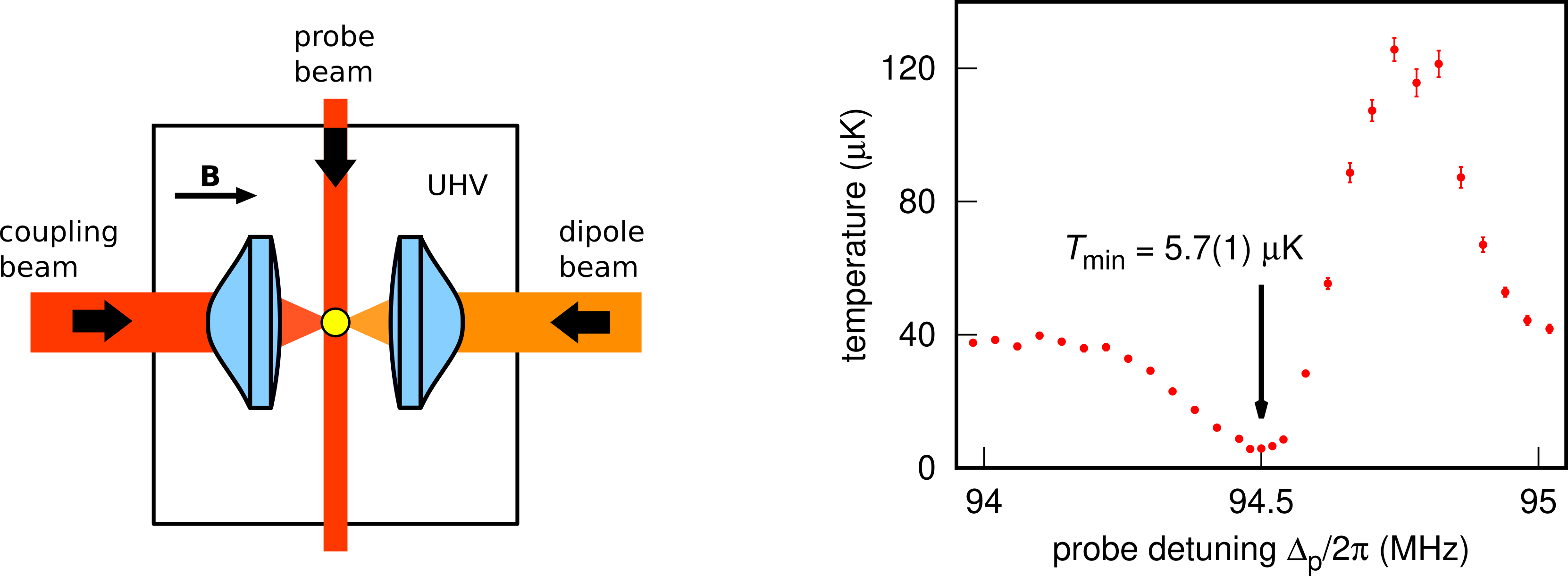
Read the paper:
C.H. Chow, B.L. Ng, V. Prakash, C. Kurtsiefer
Phys. Rev. Research 6, 023154 (2024),
arXiv:2312.06438
Observation of Mollow Triplet from an optically confined single atom
The investigation of fluorescence emitted from resonantly excited atomic systems has played a major role in understanding the interaction between atom and radiation. We experimentally characterize the fluorescence of a single optically trapped $^{87}$Rb atom. In the weak excitation limit, the fluorescence spectrum of a two-level atom shows a single scattering peak centered at the excitation frequency. When the driving intensity increases above saturation, we manage to observe the transition of the single peak spectrum evolves into a triplet structure, known as the Mollow triplet. Under off-resonant excitation, the asymmetry in correlations between photons from two sidebands of the fluorescence spectrum indicates that there is a preferred time-ordering of the emitted photons.

Read the paper:
B.L. Ng, C.H. Chow, C. Kurtsiefer
Phys. Rev. A 106,
063719 (2022), arXiv:2208.06575
Nonlinear photon-atom coupling with 4Pi microscopy
Implementing nonlinear interactions between single photons and single atoms is at the forefront of optical physics. Motivated by the prospects of deterministic all-optical quantum logic, many efforts are currently underway to find suitable experimental techniques. Focusing the incident photons onto the atom with a lens yielded promising results, but is limited by diffraction to moderate interaction strengths. However, techniques to exceed the diffraction limit are known from highresolution imaging. Here, we adapt a super-resolution imaging technique, 4Pi microscopy, to efficiently couple light to a single atom. We observe 36.6(3)% extinction of the incident field, and a modified photon statistics of the transmitted field – indicating nonlinear interaction at the singlephoton level. Our results pave the way to few-photon nonlinear optics with individual atoms in free space.
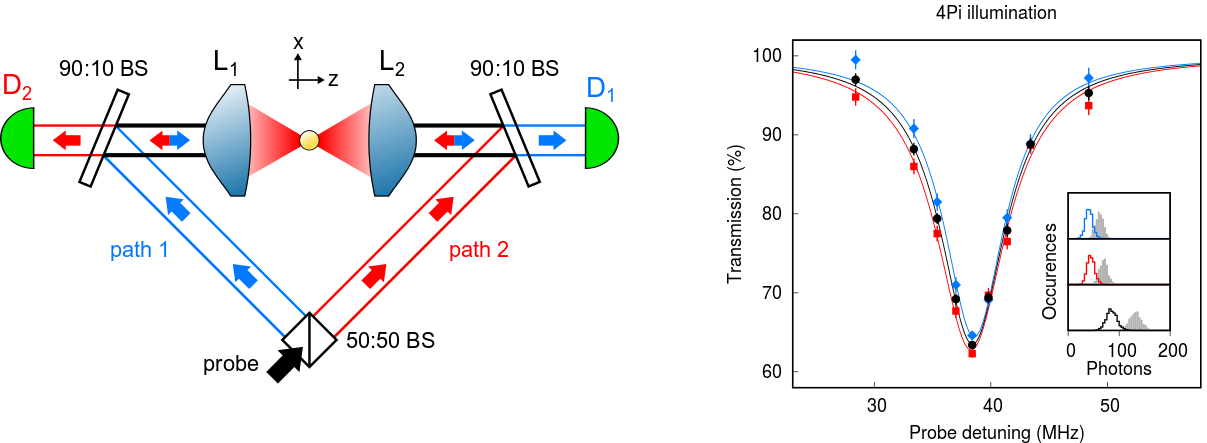
Read the paper:
Y.-S. Chin, M. Steiner, C. Kurtsiefer
Nature Communications 8, 1200 (2017),
arXiv:1705.10173
Polarization gradient cooling of single atoms in optical dipole traps
We experimentally investigate polarization gradient cooling (PGC) of a single 87Rb atom in a tightly focused dipole trap and show that the cooling limit strongly depends on the polarization of the trapping field. For optimized cooling light power, the temperature of the atom reaches 10.4(6) μK in a linearly polarized trap, approximately five times lower than in a circularly polarized trap. The inhibition of PGC is qualitatively explained by the fictitious magnetic fields induced by the trapping field. We further demonstrate that switching the trap polarization from linear to circular after PGC induces only minor heating.
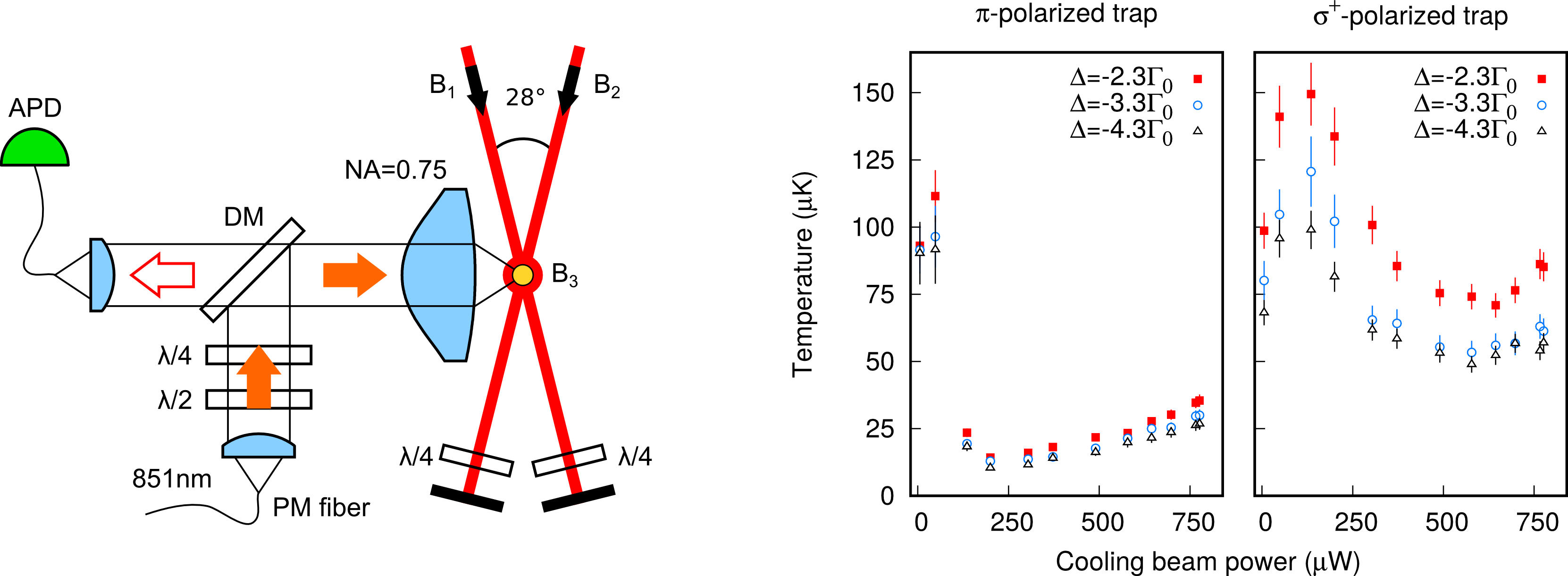
Read the paper:
Y.-S. Chin, M. Steiner, C. Kurtsiefer
Phys. Rev. A 96,
033406 (2017),
arXiv:1707.05965
Quantifying the role of thermal motion in free-space light-atom interaction
We demonstrate 17.7(1)% extinction of a weak coherent field by a single atom. We observe a shift of the resonance frequency and a decrease in interaction strength with the external field when the atom, initially at 21(1) µK, is heated by the recoil of the scattered photons. Comparing to a simple model, we conclude that the initial temperature reduces the interaction strength by less than 10%.

Read the paper:
Y.-S. Chin, M. Steiner, C. Kurtsiefer
Phys. Rev. A 95,
043809 (2017),
arXiv:1611.08048
Photon bandwidth dependence of light-matter interaction
We investigate the scattering of single photons by single atoms and, in particular, the dependence of the atomic dynamics and the scattering probability on the photon bandwidth. We tightly focus the incident photons onto a single trapped 87Rb atom and use the time-resolved transmission to characterize the interaction strength. Decreasing the bandwidth of the single photons from 6 to 2 times the atomic linewidth, we observe an increase in atomic peak excitation and photon scattering probability.

Read the paper:
M. Steiner, V. Leong, M.A. Seidler, A. Cerè, C. Kurtsiefer
Optics Express 25(6),
6294-6301 (2017),
arXiv:1701.07197
Time-resolved Scattering of a Single Photon by a Single Atom
Scattering of light by matter has been studied extensively in the past. Yet, the most fundamental process, the scattering of a single photon by a single atom, is largely unexplored. One prominent prediction of quantum optics is the deterministic absorption of a traveling photon by a single atom, provided the photon waveform matches spatially and temporally the time-reversed version of a spontaneously emitted photon. Here, we experimentally address this prediction and investigate the influence of the temporal profile of the photon on the scattering dynamics using a single trapped atom and heralded single photons. In a time-resolved measurement of the atomic excitation we find a 56(11)% increase of the peak excitation by photons with an exponentially rising profile compared to a decaying one. This result demonstrates that tailoring the envelope of single photons enables precise control of the photon-atom interaction.

Read the paper:
V. Leong, M.A. Seidler, M. Steiner, A. Cerè, C. Kurtsiefer
Nature Communications 7
(2016),
arXiv:1604.08020
Hong-Ou-Mandel interference between triggered and heralded single photons from separate atomic systems
We present Hong-Ou-Mandel interference of single photons generated via two different physical processes by two independent atomic systems: scattering by a single atom, and parametric generation via four-wave mixing in a cloud of cold atoms. Without any spectral filtering, we observe a visibility of V=62±4%. After correcting for accidental coincidences, we obtain V=93±6%. The observed interference demonstrates the compatibility of the two sources, forming the basis for an efficient quantum interface between different physical systems.

Read the paper:
V. Leong, S. Kosen, B. Srivathsan, G. K. Gulati, A. Cerè, C. Kurtsiefer
Physical Review A 91
(2015),
arXiv:1504.00818
Excitation of a single atom with exponentially rising light pulses
We investigate the interaction between a single atom and optical pulses in a coherent state with a controlled temporal envelope. In a comparison between a rising exponential and a square envelope, we show that the rising exponential envelope leads to a higher excitation probability for fixed low average photon numbers, in accordance with a time-reversed Weisskopf-Wigner model. We characterize the atomic transition dynamics for a wide range of the average photon numbers and are able to saturate the optical transition of a single atom with ≈50 photons in a pulse by a strong focusing technique.

Read the paper:
S. A. Aljunid, G. Maslennikov, Y. Wang, H. L. Dao, V. Scarani, C. Kurtsiefer
Physical Review Letters 111
(2013),
arXiv:1304.3761
Interaction of light with a single atom in the strong focusing regime
We consider the near-resonant interaction between a single atom and a focused light mode, where a single atom localized at the focus of a lens can scatter a significant fraction of light. Complementary to previous experiments on extinction and phase shift effects of a single atom, we report here on the measurement of coherently backscattered light. The strength of the observed effect suggests combining strong focusing with the well-established methods of cavity QED. We consider theoretically a nearly concentric cavity, which should allow for a strongly focused optical mode. Simple estimates show that in a such case one can expect a significant single photon Rabi frequency. This opens new perspectives and a possibility to scale up the system consisting of many atom+cavity nodes for quantum networking due to a significant technical simplification of the atom-light interfaces.

Read the paper:
S.A. Aljunid, B. Chng, M. Paesold, G. Maslennikov, C. Kurtsiefer
Journal of Modern Optics 58
(2011),
arXiv:1006.2191
Phase shift of a weak coherent beam induced by a single atom
We report on a direct measurement of a phase shift on a weak coherent beam by a single Rb atom in a Mach-Zehnder interferometer. By strongly focusing the probe mode to the location of the atom, a maximum phase shift of about 1° is observed experimentally.
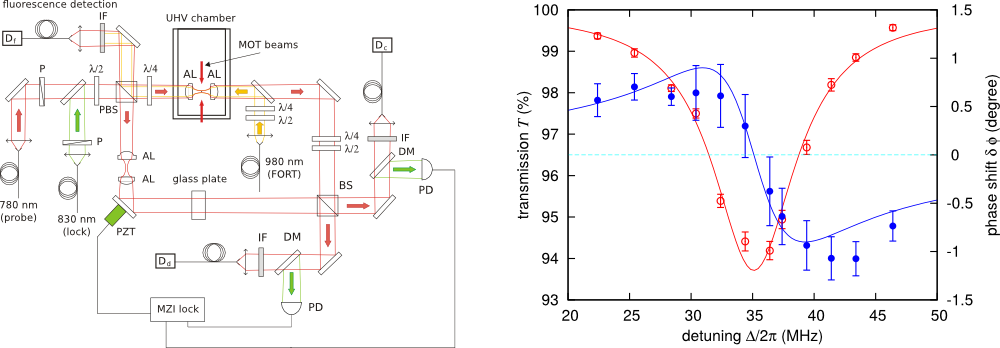
Read the paper:
S.A. Aljunid, M.K. Tey, B. Chng, T. Liew, G. Maslennikov, V. Scarani, C. Kurtsiefer
Physical Review Letters 103
(2009),
arXiv:0905.3734
Interfacing light and single atoms with a lens
We characterize the interaction between a single atom or similar microscopic system and a light field via the scattering ratio. For this, we first derive the electrical field in a strongly focused Gaussian light beam, and then consider the atomic response. Following the simple scattering model, the fraction of scattered optical power for a weak coherent probe field leads to unphysical scattering ratios above 1 in the strong focusing regime. A refined model considering interference between the exciting and scattered field into finite-sized detectors or optical fibers is presented, and compared with experimental extinction measurements for various focusing strengths.
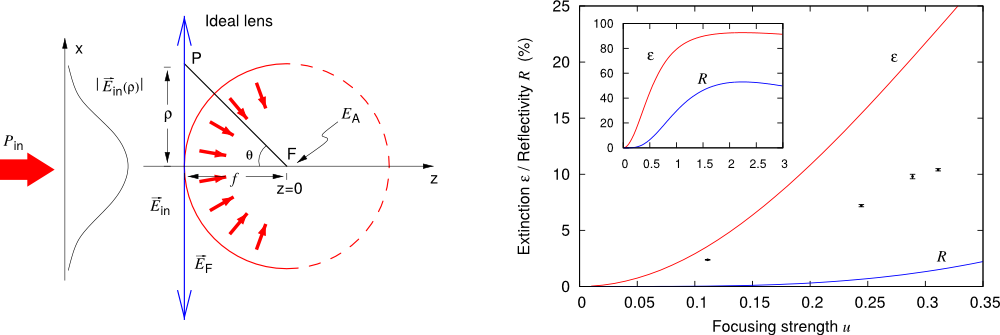
Read the paper:
M.K. Tey, G. Maslennikov, T.C.H. Liew, S.A. Aljunid, F. Huber, B. Chng, Z. Chen, V. Scarani, C. Kurtsiefer
New Journal of Physics 11 (2009),
arXiv:0804.4861
Strong interaction between light and a single trapped atom without the need for a cavity
Many quantum information processing protocols require efficient transfer of quantum information from a flying photon to a stationary quantum system. To transfer information, a photon must first be absorbed by the quantum system. This can be achieved, with a probability close to unity, by an atom residing in a high-finesse cavity. However, it is unclear whether a photon can be absorbed effectively by an atom in a free space. Here, we report on an observation of substantial extinction of a light beam by a single Rb atom through focusing light to a small spot with a single lens. The measured extinction values can be directly compared to the predictions of existing free-space photon–atom coupling models. Our result should open a new perspective on processing quantum information carried by light using atoms, in particular for experiments that require strong absorption of single photons by an atom in free space.
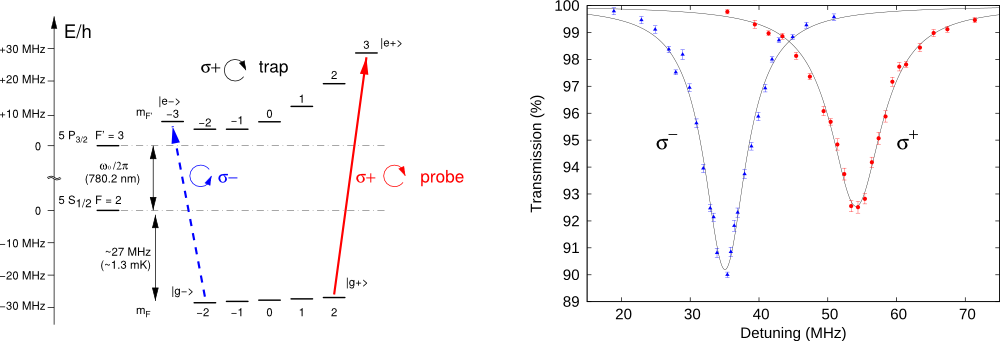
Read the paper:
M.K. Tey, Z. Chen, S.A. Aljunid, B. Chng, F. Huber, G. Maslennikov, C. Kurtsiefer
Nature Physics 4, 924-927
(2008),
arXiv:0802.3005

